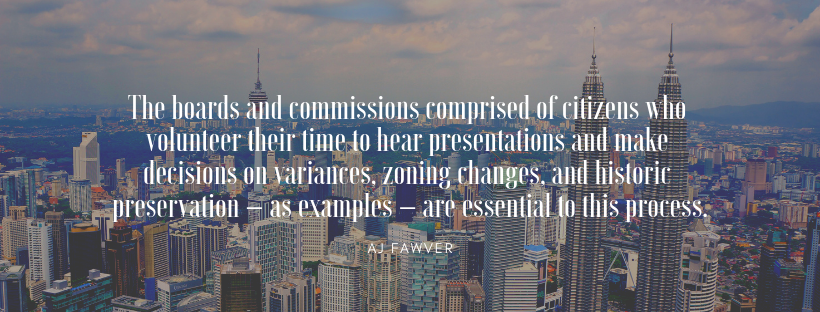
This is the monthly blog series by AJ Fawver, the Planning Director in Lubbock, Texas. She shares her perspectives on land use, planning, and community development in this series.
 In our work of planning and shaping cities, we can’t do it alone. The boards and commissions comprised of citizens who volunteer their time to hear presentations and make decisions on variances, zoning changes, and historic preservation – as examples – are essential to this process.
In our work of planning and shaping cities, we can’t do it alone. The boards and commissions comprised of citizens who volunteer their time to hear presentations and make decisions on variances, zoning changes, and historic preservation – as examples – are essential to this process.
As I finished reporting for our boards’ bodies of work in 2018, I was reminded of the amount of time these volunteers devote to us, and to the city. I think it is a good reminder for us all.
How can we demonstrate respect for their time and help them feel empowered and successful in their positions?
Well, there are a number of things. Let me start with addressing the topic of ongoing training. I cannot begin to emphasize how infrequently many organizations set aside time to provide training for their board members.
When I talk about training, I am not referring to an annual refresher on the Open Meetings Act or rules of order. Yes, those are important. However, it is well worth a few minutes of time to ask yourself – or your staff – to review this short checklist. In the last two years, how often has your department or organization:
- Had a meaningful conversation with board and commission members about topics they want to learn more about?
- Briefed your members on pending or recently-finalized legislation?
- Provided background and implications of recent court cases?
- Discussed current trends and issues emerging in the field?
- Provided information on how to join a related professional association?
- Reported on emerging patterns in the types of requests being directed to them?
- Set aside time to review components of the city’s adopted zoning, design, subdivision, or development regulations?
- Conveyed information about spatial patterns, projected growth, cost of development, neighborhood preservation, or other similar information utilizing maps and graphics?
- Helped them to understand the interdisciplinary relationships between the comprehensive plan and other types of adopted plans, such as thoroughfare plans, downtown plans, capital improvement plans, design standards, target neighborhood assessments, or other documents?
- Presented refreshers on the adopted comprehensive plan or a report on the implementation of that plan?
If you haven’t done any of these things – it is time to sit down and schedule the time to make it happen. If you have checked off 4-5 of the 10 items above, you’re off to a good start. If you have checked off the majority of the items, message me and let me know! I want to recognize you!
In addition to training, an ongoing dialogue is extremely important. Many of us have performance measures in our organization. I always have a performance measure tied to board and commission satisfaction.
It is very simple to use a tool like Survey Monkey and send a short survey to your members on an annual basis (or whatever frequency you prefer) and ask them to rank your department/team on factors such as the:
- quality of the presentations
- ability of the staff to answer questions clearly
- quality and timeliness of the reports/agenda packet
- availability of staff outside regularly scheduled meetings
- clarity of the staff recommendations and/or analysis
It is true that there will always be someone who may not participate. It is also true that the feedback is invaluable. It is a great indicator of how your team is doing, and helpful in teaching staff members to adapt and keep their audience (not just board members, but the public as well) in mind.
Revisit your staff report structure periodically. The best staff reports are easy to skim, with the most important information prominently displayed. They are concise but thorough. There are several great resources out there on building great staff reports, including:
- This report by the Institute for Local Government
- The March 2017 edition of Planning Magazine
- Planetizen’s course on Producing Engaging Documents
- This piece by the University of Kansas School of Public Affairs & Administration
Work with your board members on this as well. Ask them what they like and do not like about the current format and layout. Make sure that the documents you are producing look great in print as well as electronically (for example, on tablets). Reports don’t have to be boring! Consider the use of logos, headings, or sidebars to break up the page visually.
Another way to help your board members perform at their best – and make their lives easier – is to work out issues in advance of the meeting. Observe your members and get to know their perspectives, and it will help you better anticipate questions they are likely to ask. Meet with the team in advance of the meeting to “test” the proposed staff recommendations and work together to identify items likely to arise.
Being well prepared keeps hearings moving smoothly. In addition, work with the applicants. If it is clear that a request will not be supported, think through alternatives. Empower case managers to talk to their applicants and try to identify a different approach that better conforms to the city’s plan, or conditions which would address problems likely to come up in the hearing process. Rather than simply processing and reacting to applications, plan! I promise it is worth the effort.
Lastly, thank them. Appreciation costs nothing. From time to time, let them know you appreciate their questions and comments. Check in with them to see how they think things are going. It makes a difference.
Start the new year with a renewed commitment to partner with your boards and commissions, and set the example for your planning team to creatively and consistently be the resource these groups need.
